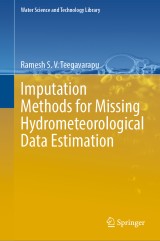Details

Imputation Methods for Missing Hydrometeorological Data Estimation
Water Science and Technology Library, Band 108
|
149,79 € |
|
| Verlag: | Springer |
| Format: | |
| Veröffentl.: | 20.07.2024 |
| ISBN/EAN: | 9783031609466 |
| Sprache: | englisch |
Dieses eBook enthält ein Wasserzeichen.
Beschreibungen
<p>Missing data is a ubiquitous problem that plagues many hydrometeorological datasets. Objective and robust spatial and temporal imputation methods are needed to estimate missing data and create error-free, gap-free, and chronologically continuous data. This book is a comprehensive guide and reference for basic and advanced interpolation and data-driven methods for imputing missing hydrometeorological data. The book provides detailed insights into different imputation methods, such as spatial and temporal interpolation, universal function approximation, and data mining-assisted imputation methods. It also introduces innovative spatial deterministic and stochastic methods focusing on the objective selection of control points and optimal spatial interpolation. The book also extensively covers emerging machine learning techniques that can be used in spatial and temporal interpolation schemes and error and performance measures for assessing interpolation methods and validating imputed data. The book demonstrates practical applications of these methods to real-world hydrometeorological data. It will cater to the needs of a broad spectrum of audiences, from graduate students and researchers in climatology and hydrological and earth sciences to water engineering professionals from governmental agencies and private entities involved in the processing and use of hydrometeorological and climatological data.</p>
<p> </p>
<p> </p>
<p> </p>
<p> </p>
<p>Introduction to Missing Data.- Methods for Imputation of Missing Data.- Temporal Interpolation Methods.- Spatial Interpolation Methods.- Data Driven Modes for Imputation.- Multiple Imputation Methods.- Evaluation of Methods and Imputed Data.</p>
<p>Dr. Ramesh Teegavarapu (Dr. T.) is a professor and a former graduate program director in the Department of Civil, Environmental, and Geomatics Department at Florida Atlantic University (FAU), Boca Raton, Florida, and founder and leader of the Hydrosystems Research Laboratory (HRL) in the department. He is a Fulbright scholar and a specialist. He has over twenty-five years of experience in hydrological modeling and water and environmental systems management. His research interests include climate variability and change, hydrometeorology, precipitation, spatial analysis, hydroanalytics and hydroinformatics, water and environmental systems modeling, and statistical learning. Before his tenure at FAU, he worked at the University of California, Davis, Kentucky Water Resources Research Institute (KWRRI), and the University of Kentucky. Dr. T. has received several national and international awards/recognitions for his research. He serves on the editorial board of multiple international peer-reviewed journals. Dr. T. has published over one hundred and fifty technical articles in high-impact journals and conference proceedings. He has authored over thirty-five book chapters and is an author, co-editor, and sole editor of books from reputed international publishers. He served on multiple national and international technical committees related to water and climate change and held visiting professor appointments in India, Italy, and Japan. Dr. T. has presented over one hundred and eighty research talks, including several invited keynote and plenary lectures at conferences and universities worldwide. He has organized, chaired, convened, and moderated over ninety technical sessions at national and international conferences. He has served on advisory committees of conferences and as general and technical co-chair of two international conferences. Dr. T. has designed and developed several innovative simulation and modeling environments/tools for understanding hydrological processes, processing and improving hydrometeorological observations, and analyzing hydroclimatic variables. </p>
<p>This book serves as a unique reference that provides a comprehensive discussion about the state-of-the-art spatial and temporal, statistical, and data mining methods for imputation of missing hydrometeorological data. The primary audience for this book are researchers, scientists, graduate-level and higher students, modelers, data scientists working in hydrological, meteorological, climatological, and earth sciences. Data analysts in other disciplines will also be interested in this book.</p>
<p>The book appeals to graduate students, researchers in civil and environmental engineering, geosciences, climatology, and hydrological and data sciences. It will be an ideal reference book for state and federal agencies that collect and process hydrometeorological and climatological data. Engineering professionals, hydrologists, meteorologists, and data and spatial analysts dealing with large hydrometeorological datasets. Researchers and modelers involve in the development of long-term datasets at national and international institutions.</p>
<p> </p>
<p>The book appeals to graduate students, researchers in civil and environmental engineering, geosciences, climatology, and hydrological and data sciences. It will be an ideal reference book for state and federal agencies that collect and process hydrometeorological and climatological data. Engineering professionals, hydrologists, meteorologists, and data and spatial analysts dealing with large hydrometeorological datasets. Researchers and modelers involve in the development of long-term datasets at national and international institutions.</p>
<p> </p>
Is a reference work for those interested in methods for imputation of missing data Focuses on hydrometeorological data infilling methods Emphasizes on practical applications of the methods and elaborates on case studies

















